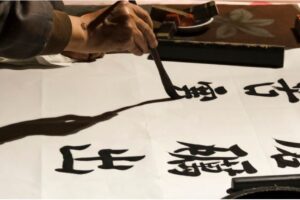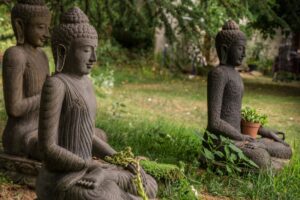
Last Saturday, we held the fourth annual conference of the network of Zen centers and sitting groups affiliated with Atlanta, hosting attending Practice Leaders and local interested members, Disciples and Priests, and followed by our annual Precepts Ceremony (J. Jukai) for six new Initiates, formally declaring themselves Soto Zen Buddhists (photos will be posted online).
Others attended via Skype; the proceedings were recorded and will be made available for those of you who were unable to attend, or chose not to, for whatever reasons. As usual, we reviewed reports of where we are as an organization, and discussed where we are going, particularly with regard to the relationship between the Affiliates and the Practice Center. More to follow on any changes for 2015 and beyond, some of which promise to be dramatic.
Like Janus, the Roman god of yore, it occasionally makes sense to take the time to look back upon where we have been, and to speculate as to where we are going. Of course, Buddhism looks down on rank speculation, especially in terms of the Great Matter, or the Ten Cosmic Questions, but in everyday, pragmatic matters of causality, not to mention Karma, we do not ignore the Three Times. The Wikipedia definition of Janus includes:
In ancient Roman religion and myth, Janus…the god of beginnings and transitions, and thereby of gates, doors, doorways, passages and endings. He is usually depicted as having two faces, since he looks to the future and to the past. The Romans named the month of January…in his honor.
I am fully cognizant that it is not January, but here at the middle of the year, we are reaching another turning point, one of many in the history of our sojourn in Atlanta, which may mark a major transition, a beginning of a new phase of our dharma family. It is a truly great success story, which should inspire us all to continue.
I may be the only person who knows, or cares, about the history of where the Atlanta Soto Zen Center (ASZC), and later the Silent Thunder Order (STO) came from, so some of the details may be new to you. But I think it important that as we look at the present reality for ASZC, we understand some of the reasons it has come to be the way it is.
In the STO, we regard the Zen community (S. Sangha) as being much like a cloud. Our “family” name is Un, Japanese for “cloud,” derived from my first dharma name, given to me by Matsuoka Roshi at my ordination as a Disciple (J. Shukke Tokudo) in the 1960s at the Chicago Zen Buddhist Temple (CZBT). Like a cloud, the ASZC community, and the STO community at large, seem to have a definitive form with any snapshot taken, but in the next moment, are seen shape-shifting, morphing from a bunny to a dragon, or vice-versa. The drops of water that make up the cloud, the individual practitioners, keep coming and going, their lives moving on in what sometimes seems like random Brownian motion.
In 1970, when Matsuoka Roshi moved to Long Beach and began establishing a Zen center there, I moved to Atlanta for various personal and professional reasons. Kongo Roshi, my senior dharma brother, took over the CZBT. The other Disciples in Chicago, when hearing of my plans, declared somewhat scornfully, “Southerners don’t do Zen!” My point exactly. Establishing the southern school is a hoary and honored tradition in Zen. I was not moving to the Southeast primarily to establish a Zen center, but must admit that it was in the back of my mind. I suspended my public activities in Zen for a few years, while re-establishing my lifestyle and location, with a new iteration of a company I had worked with in Chicago, while teaching at the universities there.
In the intervening years, Matsuoka Roshi and I stayed in touch, mostly through his monthly newsletter, and we would visit from time to time in Atlanta, Long Beach, and Chicago, the Bermuda Triangle of our lineage at the time. We also met in Tokyo, later when we both traveled there at the same time, but not together. The Internet was just coming into being at that time, so the opportunities for frequent dialog were relatively restricted.
In 1974, my life went through another transition, and I began offering classes in Zen meditation at the Cliff Valley Way Unitarian Universalist Congregation. After arriving in Atlanta with one sitting cushion (zafu), I found myself hauling two trash bags of zafus into and out of the church, on a weekly basis. Sometime later, we found a storefront and moved the sitting space there.
Over years of moving zendos, from living room to loft space, to storefront, and back, I learned that having the public come into one’s private home once or twice a week is not a real good idea. In fact, most of the design of the program for ASZC and STO, including our approach to fostering startups, has been developed at the expense of myself and my family, in good faith experiments that often went awry in one way or another. Without the patience of my family, my wife (J. okusan) in particular, there would be no ASZC today, let alone STO. It is a well-known fact, in Zen circles, that if you want to know the truth behind the façade of any Zen center, talk to Okusan. But she will probably not talk to you about it.
Believe it or not, we still have one attending member from our storefront days. Others have come and gone, condensing and evaporating rapidly, like those who show up once at Newcomers’ Workshop, and never again; others disappearing after years of practice, and showing up again after a decade or more of absence. I used to wonder and worry about it, but came to the conclusion that I cannot be concerned about those Sangha members who do not attend — there are about 7 billion of them — we have enough to worry about with those who do show up.
In 1977, we incorporated ASZC as a 501c3 NFP under the charter of the State of Georgia. The two dedicated members who did most of the grunt (paper) work being two of the many drops that have since evaporated. I did run into one of them, years later, at a local garden center, and years later, the other, on the train in Chicago, of all places, where we both happened to be by coincidence (of which there is no such thing according to Zen). Small world. Some decades later, STO was incorporated through the generous donation of another member’s time, including the fees, a person who still attends now and then.
So the existence and form of the ASZC and its Affiliates, organized under the umbrella of STO, is the product of approaching one hundred past and present members at least, and in the 37 years of continuous operation (weekly sittings plus) has introduced Zen to, and provided space and regular, dependable program of zazen and dharma studies, for untold thousands. But this is not a matter of pride for me personally, and should not be for anyone else. What we do for Zen is not selfless, nor is it selfish. It is enlightened self-interest.
As a consequence of the good faith and the efforts of may hundreds more, represented by the Practice Leaders and members of the STO, I now find myself as the guiding teacher for an organization in continuous operation since 1977, with a fully-equipped and well-appointed training center attracting 6 to 12 newcomers every week; and a staff of well-trained Disciples and Priests; four stable residents.
ASZC serves a network of a dozen or so sitting groups and Affiliate centers in the US and Canada, presently contacting a mailing list approaching 2,000 recipients, and is supported by an umbrella organization (STO) with its own 501c3 and BOD, who are assuming more responsibility and leadership as their personal lives permit, for example, now scheduling and managing the annual retreat program for the network, which heretofore has fallen to myself as one of many administrative tasks, which allows me to devote my time to teaching.
The STO currently is led by about a dozen black robes (novice Priests) at last count, two brown robes (fully transmitted Priests), and an active group of about two dozen Disciples who are assisting as Practice Leaders for affiliate groups or at the headquarters in Atlanta.
Our approach to lay practice startups, developed with incremental improvements over the years, stands as a model for expanding the network in future, for all those members whose lives take them to the hinterlands, but remain interested in practicing and propagating Zen.
We have extensive documentation, based on that of CZBT and other established centers, developed with professional graphics and the sophistication of computer-aided design applications. This includes extensive guidelines and custom-designed print formats on file for training, ceremonies, service books and other collateral necessary to the organization and administration of a Zen center.
We also enjoy fully up-and-running online presence in two major web sites and several for affiliates, and our social media program in full swing, thanks to the indefatigable efforts and patience of our webmaster, and a coterie of tech-savvy members who comprise our Online Communications team.
On the financial side, we have had our ups and downs, but have managed to keep the doors open. With the residency program now fully subscribed and stable for the first time in our history, donations can begin to go to make up our long-running deficit in compensation and other expenses (full disclosure – I am presently the only paid person presently, with a minister’s allowance).
It is to the credit of you, the supporting members of ASZC and STO, that we have been able to offer our robust program of practice and training without disruption, other than that caused by the occasional confusion of human nature rearing its ugly head. Which is why we aspire to Buddha-nature, not human nature, after all.
All told, I would say, not too shabby. Let us move into the future with confidence. We have kept the raft afloat through some pretty stormy seas, and I see no reason to worry.
So, please — begin (again), continue, and complete your (new) life in the Dharma — as we declare at the end of the Jukai ceremony. Beginner’s mind (J. shoshin) is always appropriate, moment-by-moment as well as lifetime-by-lifetime. It is highly appropriate here, as we move not the second half of the year. Please renew your practice, and your commitment to your Sangha.








